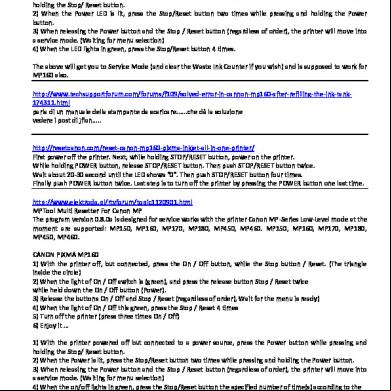Field Flashing 4t3a16
This document was ed by and they confirmed that they have the permission to share it. If you are author or own the copyright of this book, please report to us by using this report form. Report 2z6p3t
Overview 5o1f4z
& View Field Flashing as PDF for free.
More details 6z3438
- Words: 495
- Pages: 2
BCS 33th 2. (a) Flashing the Generator Field (33th BCS): Residual magnetism in the generator exciter field allows the generator to build up voltage during start-up. This magnetism is sometimes lost due to shelf time or improper operation, among other reasons. Restoring this residual magnetism is possible and is sometimes referred to as "flashing the exciter field". Problem: Insufficient residual magnetism in the exciter and generator fields Cause: Generator that has been out of service for an extended period of time may cause residual magnetism and requires field flashing. Fielding Flashing Procedure: To restore the small amount of residual magnetism necessary to begin voltage buildup, connect a 12 volt battery to the exciter field while the generator is at rest, as follows: 1. Remove exciter field leads F+ and F- from the voltage regulator. CAUTION: Failure to remove the field leads from the regulator during flashing procedures may destroy the regulator. 2. Measure the exciter field resistance from the F+ to the F- lead. You should be able to read some resistance as you are measuring a continuous winding. An infinite resistance reading would indicate an open in the exciter field. Also check to be sure there is no path to ground. 3. Connect F+ to the positive pole of the battery. 4. Hold the F- lead by the insulated portion of the lead wire, touch F- to the negative pole of the battery for about 5 to 10 seconds, then remove. 5. Reconnect F+ and F- to the regulator. Repeat the procedure if the generator fails to build voltage. (b) All day efficiency of transformer? Why all day efficiency is used instead of full load efficiency? All day efficiency : The all day efficiency is defined as the ratio of output in kilo watt hour (KWh) or watt hour (Wh) to the input in kWh or Wh of a transformer over 24 hours. Simply the ordinary or commercial efficiency of a transformer is defined as the ratio of the output power to the input power.
A transformer has mainly two types of losses, these are, iron losses and copper losses. Iron loss, which is also referred as core loss, consists of hysteresis loss and eddy current loss. These two losses are constant when the transformer is charged. That means the amount of these losses does not depend upon the condition of secondary load of the transformer. In all loading condition, these are fixed. But the copper loss which is also referred as I2R loss entirely depends upon load I. A distribution transformer cannot be run with constant load throughout 24 hours. At day peak time it’s loading is high, whereas in night lean time its loading may be negligible. So selecting a transformer depending upon its conventional efficiency is not practical and economical, too. As a solution of these problems, the concept of all day efficiency of distribution transformer came into the picture. So this efficiency is same as the efficiency of distribution transformer.
A transformer has mainly two types of losses, these are, iron losses and copper losses. Iron loss, which is also referred as core loss, consists of hysteresis loss and eddy current loss. These two losses are constant when the transformer is charged. That means the amount of these losses does not depend upon the condition of secondary load of the transformer. In all loading condition, these are fixed. But the copper loss which is also referred as I2R loss entirely depends upon load I. A distribution transformer cannot be run with constant load throughout 24 hours. At day peak time it’s loading is high, whereas in night lean time its loading may be negligible. So selecting a transformer depending upon its conventional efficiency is not practical and economical, too. As a solution of these problems, the concept of all day efficiency of distribution transformer came into the picture. So this efficiency is same as the efficiency of distribution transformer.










